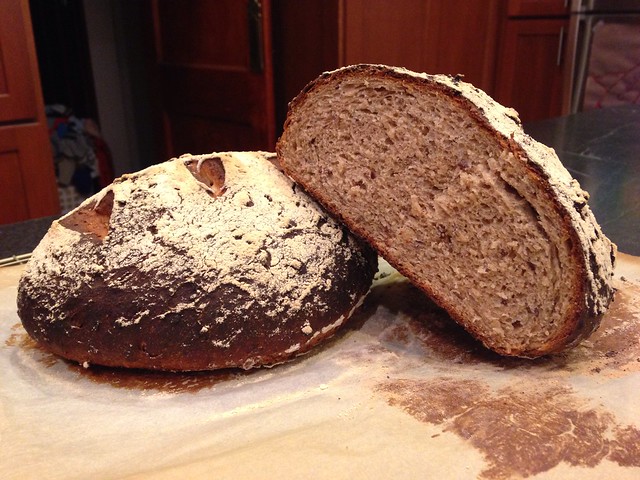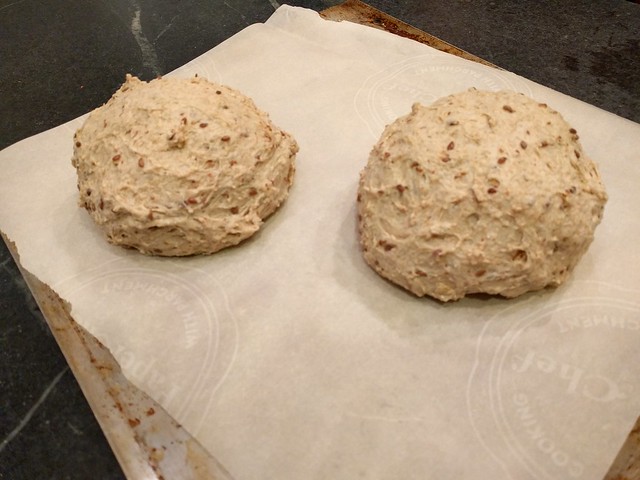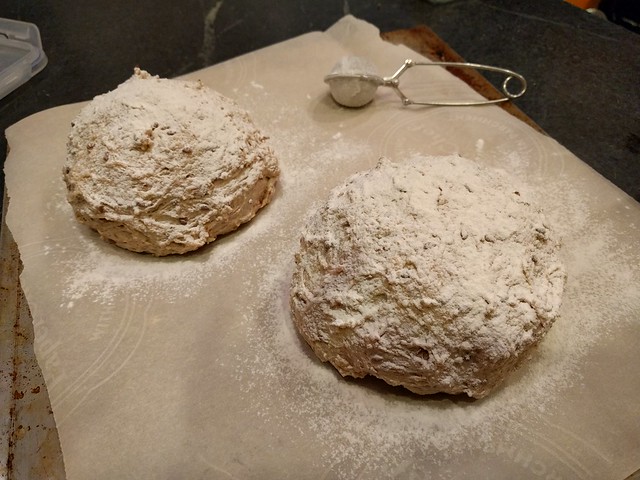Ingredients:
- 16 oz all purpose flour
- 16 oz wheat flour
- 1Tbsp table salt
- 18 g yeast (1 1/2 Tbsp)
- 3 - 4 Tbsp flax seed meal
- 3 - 4 Tbsp flax seed
- Handful rolled oats
- Juice from 1/2 orange OR 1-2 Tbsp lemon juice, OR 3-4 Tbsp Kefir (optional)
- water to add to juice/kefir to make 3 cups
- 1/4 cup olive oil
- 1/2 cup honey
- In a large bowl, combine flour(s), salt, yeast, flax seeds, flax seed meal and oats. (Mix just enough to get the seeds evenly distributed--it would be harder to do with the wet ingredients in.)
- Measure out 3 cups of water. If you are using orange juice, lemon juice or kefir, add it to the measuring cup first. Then add enough water to make 3 cups total. (No need to mix yet.) The water cannot be hot!!! Luke warm or cold is fine.
- Add olive oil and honey.
- Mix to make very rough sticky dough. You only need to mix enough to make sure that all the dry ingredients got wet, and that the ingredients are evenly distributed. I usually start with a large spoon, but then use my hands for a couple of minutes just to make sure there are no dry spots left.
- Cover the dough tightly. You may let the dough sit out for up to 2 hours at room temperature and then refrigerate. (Refrigerating right away does not seem to have an adverse effect.)
- The dough is ready in about 8-12 hours. However, it can keep in the refrigerator for at least a week. This recipe makes enough dough to make 3 medium size round loaves.
- Place a piece of parchment onto a cookie baking sheet. Don’t worry—the parchment paper will not burn in the oven. (Do not use wax paper.)
- Grease your hands with butter, deflate the dough in the bowl, and grab about a third of it to make one loaf—about the size of a large grapefruit.
- In your hands, stretch and fold the piece of dough onto itself a couple of times, and then shape it into a ball, creating tension at the surface. (You do not need to roll it.) Little video of me shaping the loaf
- Place the shaped dough onto the parchment lined baking sheet, and sift a light coating of flour over the top. (I use a tea infuser spoon to do this step.) The flour will keep the dough moist while it rises.
- Let the loaf rise at room temperature for about an hour, longer if your house is cool. It is ok to leave the loaf out longer if needed, but ideally it should be baked in about two hours at most.
- Preheat the oven to 450F, boil at least 1 cup of water, and prepare a shallow metal or cast iron pan—nothing Pyrex, ceramic or glass.
- When you’re ready to bake make 2-3 slashes in the loaf about ½ inch deep. I use kitchen shears to make the cuts, but a sharp serrated knife will work as well.
- Place the dough into the oven (middle rack). Place the prepared shallow metal pan onto the bottom rack in the oven and pour the hot water into it.
- Bake the bread for about 40 minutes. I usually rotate the baking sheet 180 degrees after the first 25 minutes. I use an instant meat thermometer to measure the internal temperature of the bread. It should be 195-205F degrees. The baking time may vary based on your oven, and how big of a loaf you are making. So you may want to start checking your bread earlier.
- Cool the bread on a rack.
This recipe was based on the No-Knead Crusty White Bread recipe by King Arthur Flour






